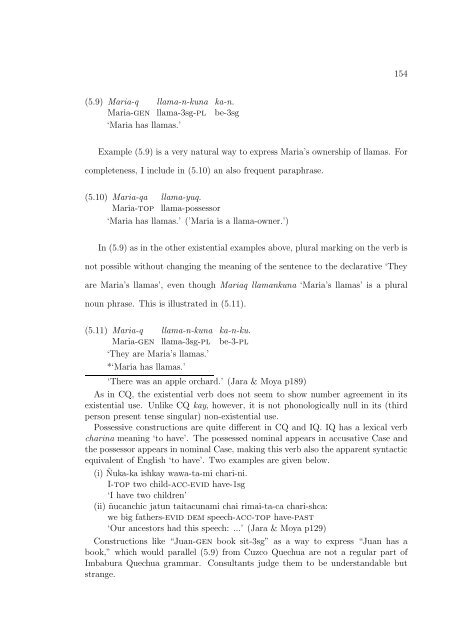the syntax and semantics of relativization and quantification
the syntax and semantics of relativization and quantification
the syntax and semantics of relativization and quantification
Create successful ePaper yourself
Turn your PDF publications into a flip-book with our unique Google optimized e-Paper software.
154<br />
(5.9) Maria-q llama-n-kuna<br />
Maria-gen llama-3sg-pl<br />
‘Maria has llamas.’<br />
ka-n.<br />
be-3sg<br />
Example (5.9) is a very natural way to express Maria’s ownership <strong>of</strong> llamas. For<br />
completeness, I include in (5.10) an also frequent paraphrase.<br />
(5.10) Maria-qa<br />
Maria-top<br />
llama-yuq.<br />
llama-possessor<br />
‘Maria has llamas.’ (’Maria is a llama-owner.’)<br />
In (5.9) as in <strong>the</strong> o<strong>the</strong>r existential examples above, plural marking on <strong>the</strong> verb is<br />
not possible without changing <strong>the</strong> meaning <strong>of</strong> <strong>the</strong> sentence to <strong>the</strong> declarative ‘They<br />
are Maria’s llamas’, even though Mariaq llamankuna ‘Maria’s llamas’ is a plural<br />
noun phrase. This is illustrated in (5.11).<br />
(5.11) Maria-q llama-n-kuna<br />
Maria-gen llama-3sg-pl<br />
‘They are Maria’s llamas.’<br />
*‘Maria has llamas.’<br />
ka-n-ku.<br />
be-3-pl<br />
‘There was an apple orchard.’ (Jara & Moya p189)<br />
As in CQ, <strong>the</strong> existential verb does not seem to show number agreement in its<br />
existential use. Unlike CQ kay, however, it is not phonologically null in its (third<br />
person present tense singular) non-existential use.<br />
Possessive constructions are quite different in CQ <strong>and</strong> IQ. IQ has a lexical verb<br />
charina meaning ‘to have’. The possessed nominal appears in accusative Case <strong>and</strong><br />
<strong>the</strong> possessor appears in nominal Case, making this verb also <strong>the</strong> apparent syntactic<br />
equivalent <strong>of</strong> English ‘to have’. Two examples are given below.<br />
(i) Ñuka-ka ishkay wawa-ta-mi chari-ni.<br />
I-top two child-acc-evid have-1sg<br />
‘I have two children’<br />
(ii) ñucanchic jatun taitacunami chai rimai-ta-ca chari-shca:<br />
we big fa<strong>the</strong>rs-evid dem speech-acc-top have-past<br />
‘Our ancestors had this speech: ...’ (Jara & Moya p129)<br />
Constructions like “Juan-gen book sit-3sg” as a way to express “Juan has a<br />
book,” which would parallel (5.9) from Cuzco Quechua are not a regular part <strong>of</strong><br />
Imbabura Quechua grammar. Consultants judge <strong>the</strong>m to be underst<strong>and</strong>able but<br />
strange.
















